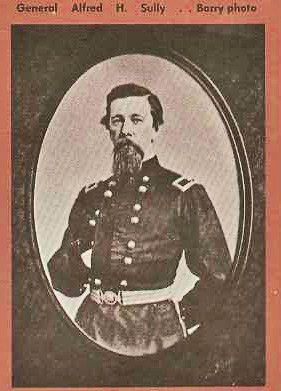|

ALFRED SULLY, (1821-1879)
Alfred Sully, son of Thomas Sully the portrait painter, was born in Philadelphia. He graduated from West Point in 1841 and was commissioned a 2d lieutenant in the 2d Infantry Regiment. Sully spent a year at Fort Russell in Florida fighting the Seminole Indians before being assigned to Madison Barracks, Sackett's Harbor, New York, where he stayed from 1842-46. He joined the American forces in Mexico in time to participate in the siege of Vera Cruz. In 1847 Sully was promoted to 1st lieutenant.
In 1848 the 2d Infantry Regiment was ordered to California and stationed first in Monterey and then Benicia. Sully, now quartermaster and a captain, participated in Indian campaigns in northern California and southern Oregon. He married Manuela Jimeno in 1850 and the couple had a son in 1851; however, both mother and child died that year.
From 1854 to 1861 Sully served on the northern plains where he encountered the Northern Cheyenne and Sioux. He commanded troops in the Dakota and Nebraska Territories near Fort Pierre, Fort Kearney, and Fort Ridgely, Minnesota. In 1861 Sully was ordered to Fort Leavenworth, Kansas, to recruit forces for the Union and to drive the rebels out of St. Joseph and Independence, Missouri. The following year, as colonel and later brigadier general of the 1st Minnesota Volunteers, Sully fought in the Virginia Peninsula campaign.
By 1863 Sully was back on the plains serving under General Pope. From 1863 to 1866 he commanded the "North Western Indian Expeditions" directed against the Arapaho, Sioux, and Cheyenne. The battles of White Stone Hills and Tah-kah-ha-kuty (or Killdeer Mountain) proved Sully's skill as an Indian fighter, and when the Congressional Joint Special Committee to Inquire into the Condition of the Indian Tribes, often referred to as the Doolittle committee, came west, Sully was asked to testify.
In 1866 Sully married Sophia Henrietta Webster, was mustered out of the Volunteers, and returned to the regular army with the rank of lieutenant colonel. He spent his last years serving on various special projects. He chaired a commission to investigate the Fetterman Massacre at Fort Kearney and to establish peace with the Indians of the Powder River country. In 1869 he became Superintendent of Indians for the Territory of Montana and in 1877 served briefly with General Howard in the Nez Perce war. Alfred Sully died in 1879 at Fort Vancouver, Washington Territory.
For additional information see Langdon Sully's biography of his grandfather, No Tears for the General: The Life of Alfred Sully, 1821-1879 (1974), a copy of which may be found in local libraries. |